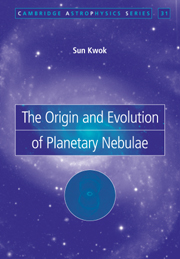Book contents
- Frontmatter
- Contents
- Preface
- 1 History and overview
- 2 Ionization structure of planetary nebulae
- 3 Nebular line radiation
- 4 Nebular continuum radiation
- 5 The neutral gas component
- 6 The dust component
- 7 Observations of the central star of planetary nebulae
- 8 Morphologies of planetary nebulae
- 9 Problems and questions
- 10 Asymptotic giant branch stars – progenitors of planetary nebulae
- 11 Evolution of the central stars
- 12 Formation of planetary nebulae
- 13 Dynamical evolution of planetary nebulae
- 14 Protoplanetary nebulae – the transition objects
- 15 Evolution to the white dwarf stage
- 16 Distances to planetary nebulae
- 17 Comparison between evolutionary models and observations
- 18 PN in the galactic context
- 19 Chemical abundances
- 20 Planetary nebulae in other galaxies
- 21 Concluding remarks
- References
- Appendix List of symbols and abbreviations
- Subject index
11 - Evolution of the central stars
Published online by Cambridge University Press: 04 November 2009
- Frontmatter
- Contents
- Preface
- 1 History and overview
- 2 Ionization structure of planetary nebulae
- 3 Nebular line radiation
- 4 Nebular continuum radiation
- 5 The neutral gas component
- 6 The dust component
- 7 Observations of the central star of planetary nebulae
- 8 Morphologies of planetary nebulae
- 9 Problems and questions
- 10 Asymptotic giant branch stars – progenitors of planetary nebulae
- 11 Evolution of the central stars
- 12 Formation of planetary nebulae
- 13 Dynamical evolution of planetary nebulae
- 14 Protoplanetary nebulae – the transition objects
- 15 Evolution to the white dwarf stage
- 16 Distances to planetary nebulae
- 17 Comparison between evolutionary models and observations
- 18 PN in the galactic context
- 19 Chemical abundances
- 20 Planetary nebulae in other galaxies
- 21 Concluding remarks
- References
- Appendix List of symbols and abbreviations
- Subject index
Summary
The study of evolution of the central stars of PN is motivated by the observed distribution of PN in the H-R diagram. Using Shklovsky distances (Section 16.1.1) and H Zanstra temperatures (Section 7.1.1), O'Dell (1963) was the first to construct a luminosity-temperature diagram for the central stars of PN. Similar results were obtained by Harman and Seaton (1964) and Seaton (1966) using Hell Zanstra temperatures. They found that both low(T* = 30,000 K) and high temperature (105 K) central stars had low luminosities (102 L⊙) and that the intermediate temperature (50,000 K) stars have high luminosities (104 L⊙). Apparently, the distribution of PN in the H-R diagram had the shape of an upside-down horse shoe, which was interpreted as an evolutionary sequence and named the Harman-Seaton sequence.
Harman and Seaton (1964) suggested that PN were formed at the end of the horizontal branch, followed by a rapid increase in temperature and luminosity of the central star. Such rapid evolution in 104 yr (the dynamical age of PN) posed a great challenge to theorists. Early efforts have concentrated on remnant stellar cores without nuclear burning, and undergoing gravitational and thermal adjustments while contracting toward the WD stages. Although artificial models with specific initial conditions could be made to mimic the Harman-Seaton sequence, the results are far from satisfactory (cf. Salpeter, 1968; Shaviv, 1978).
- Type
- Chapter
- Information
- The Origin and Evolution of Planetary Nebulae , pp. 116 - 123Publisher: Cambridge University PressPrint publication year: 2000

